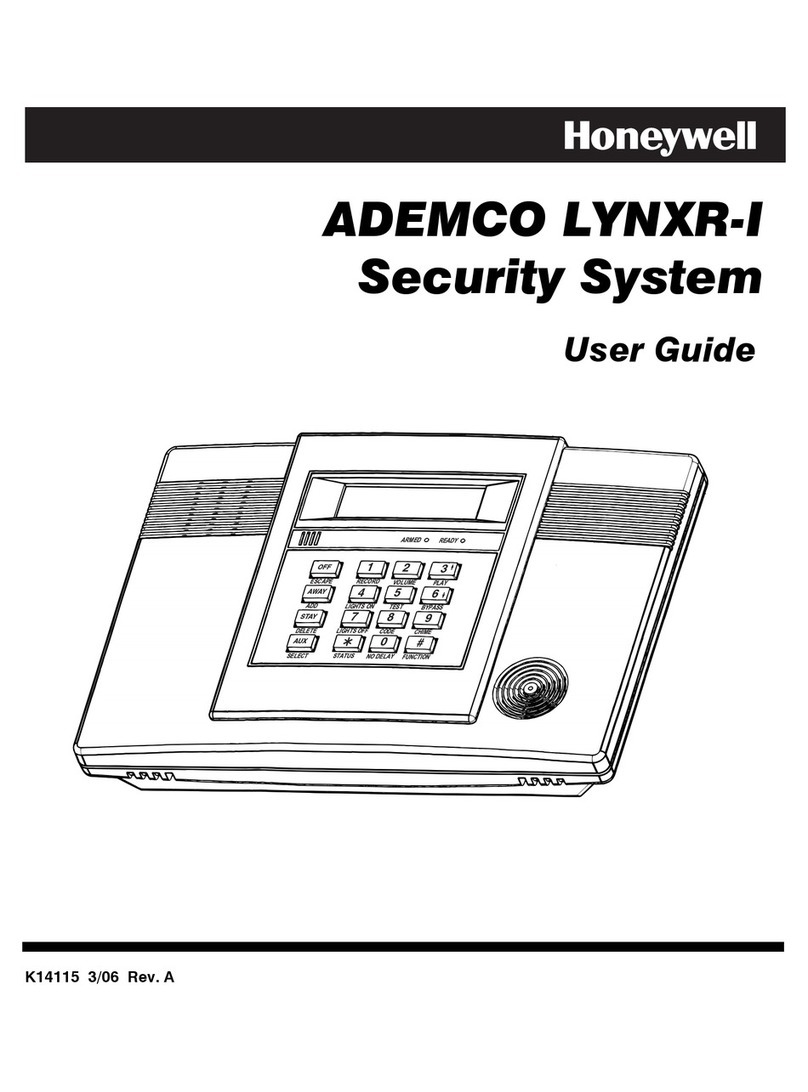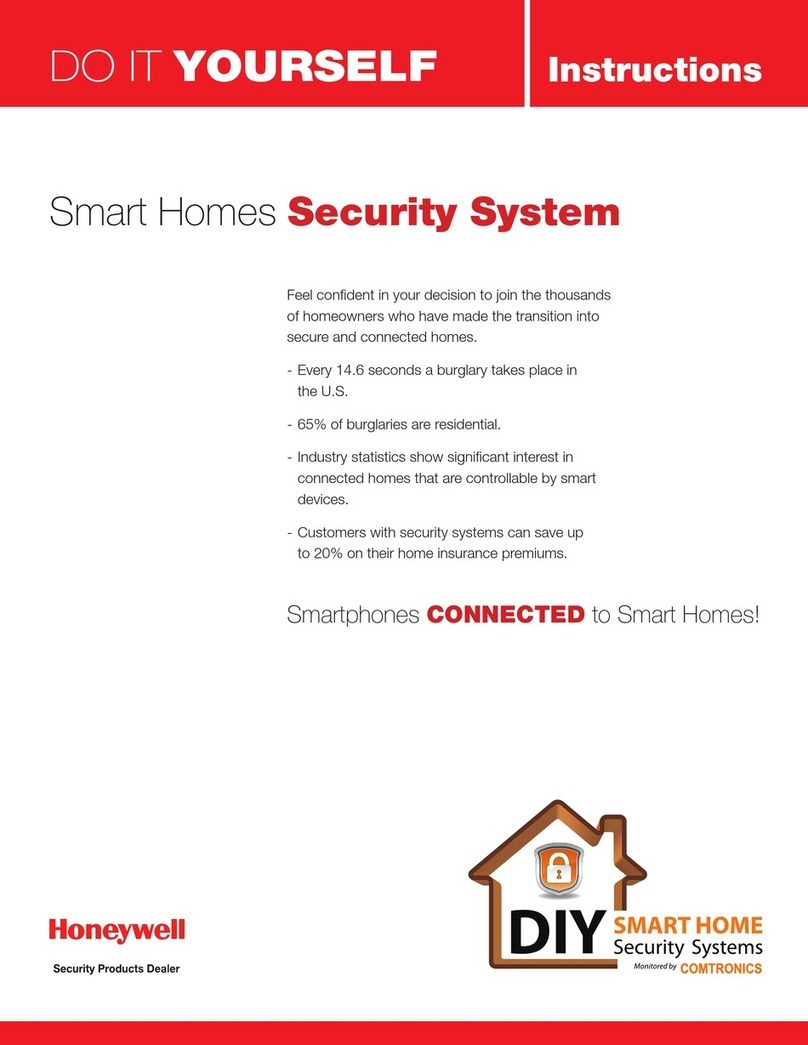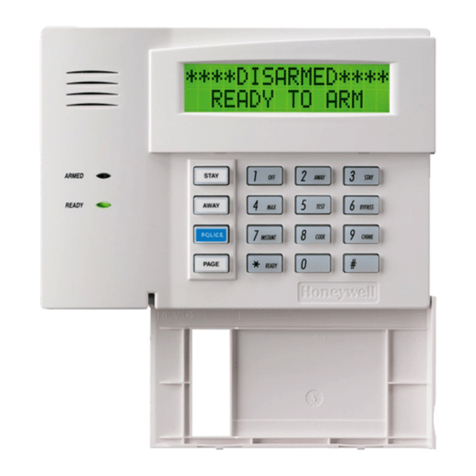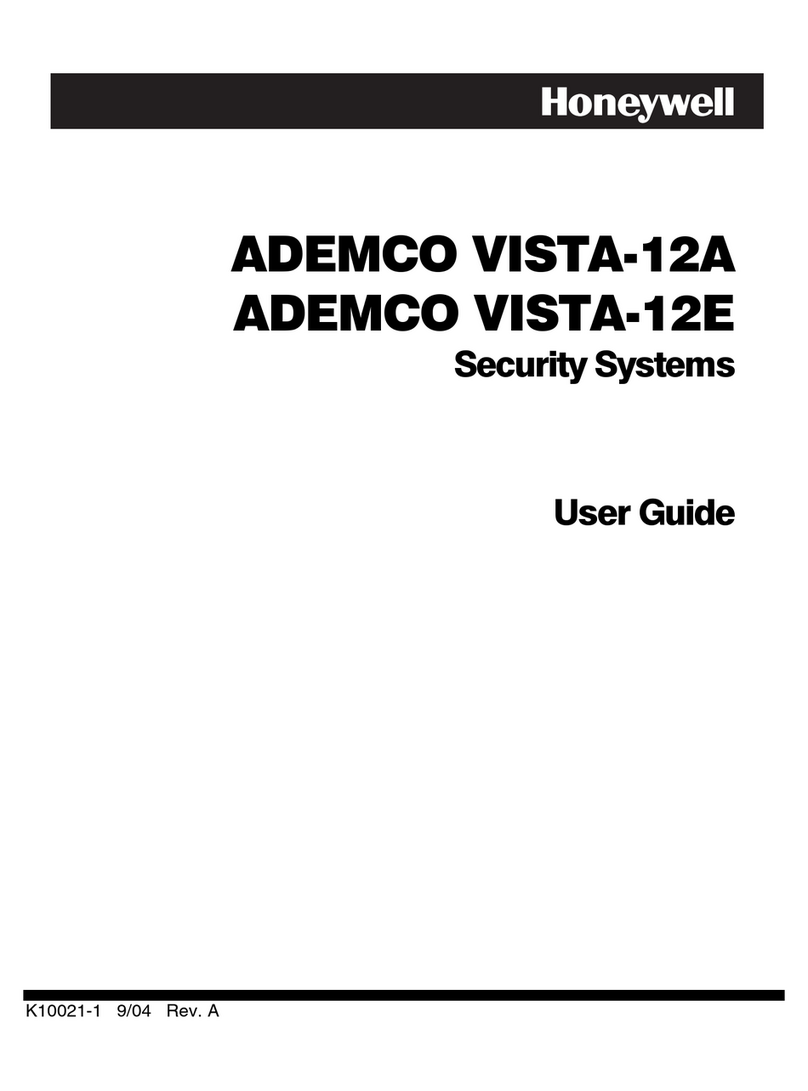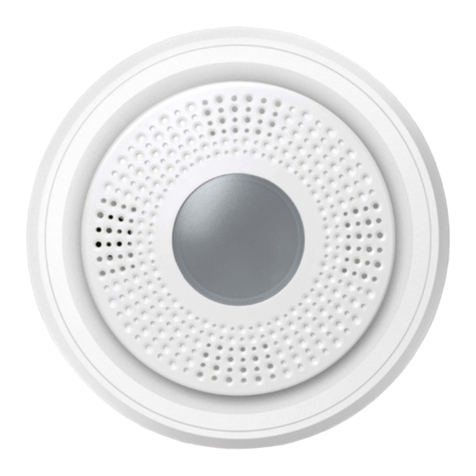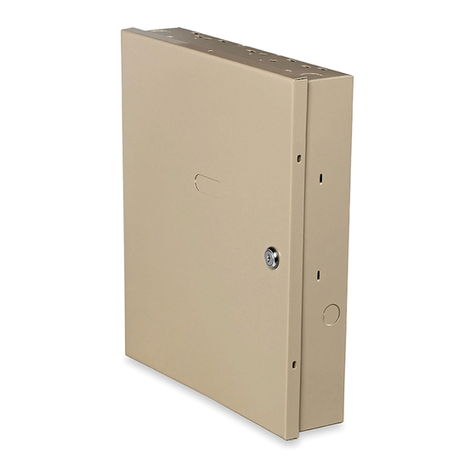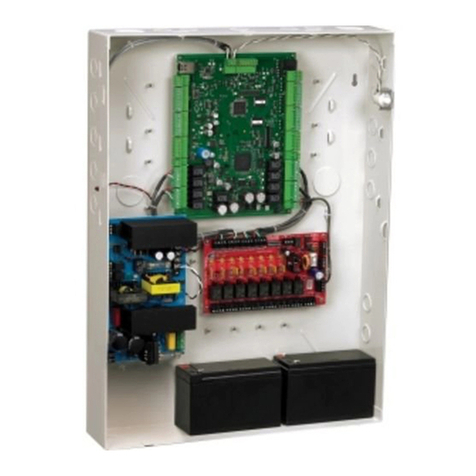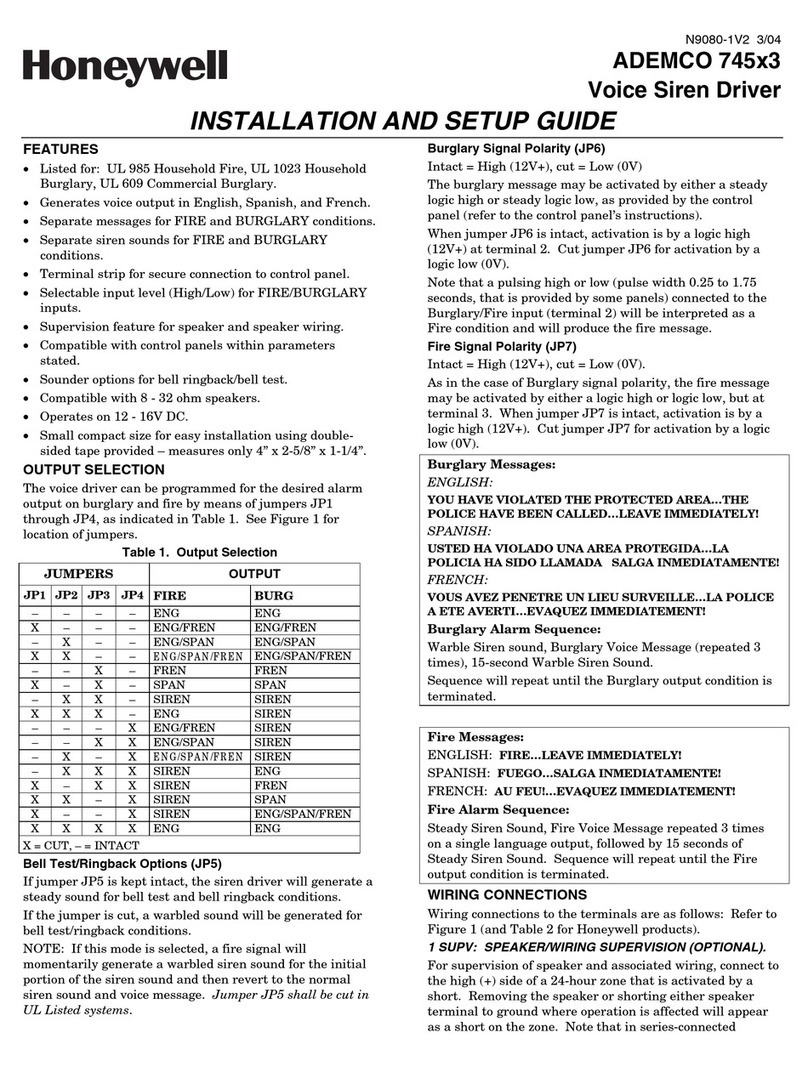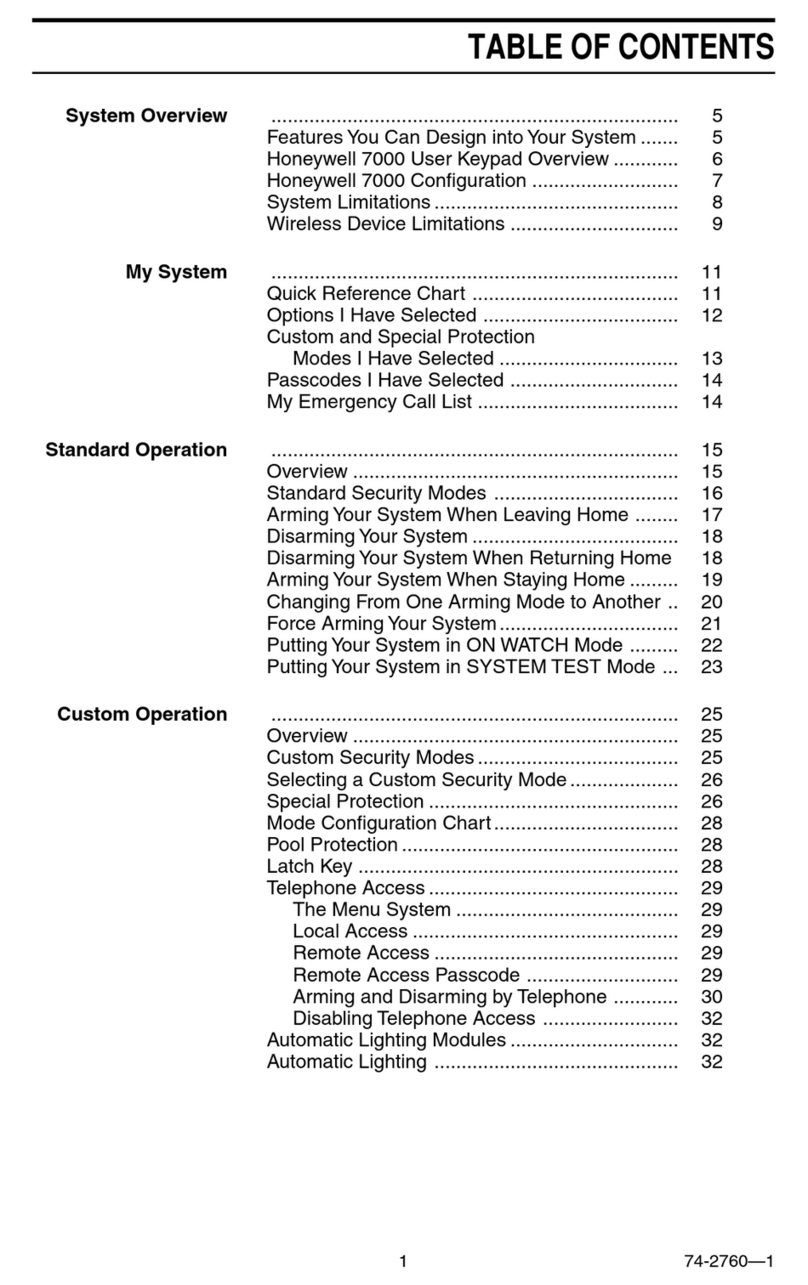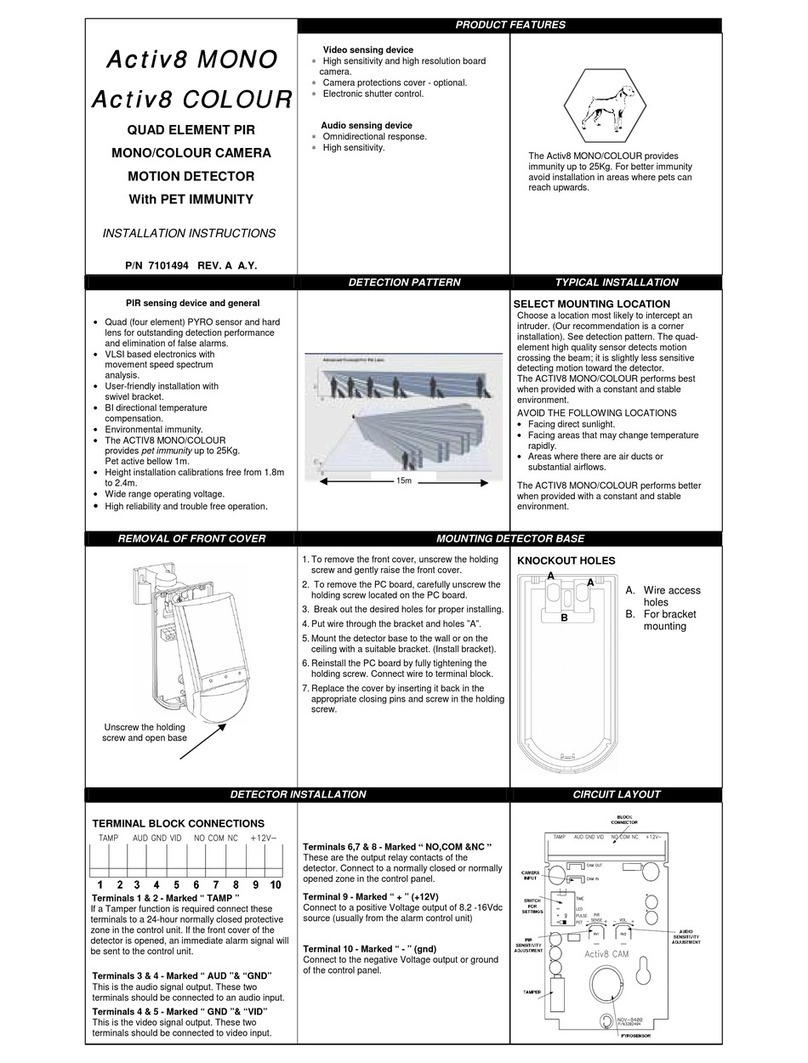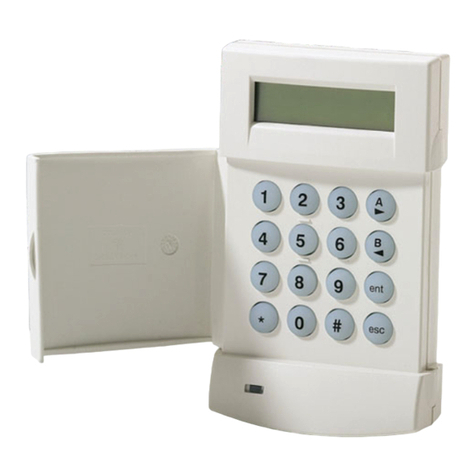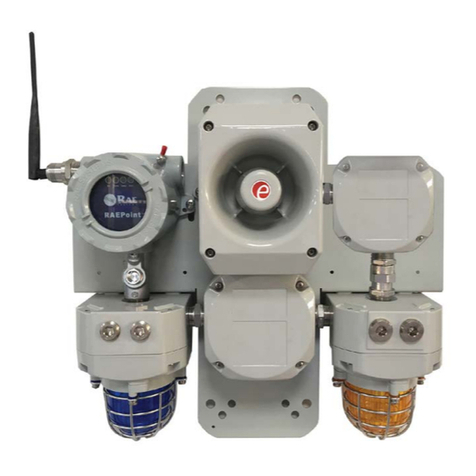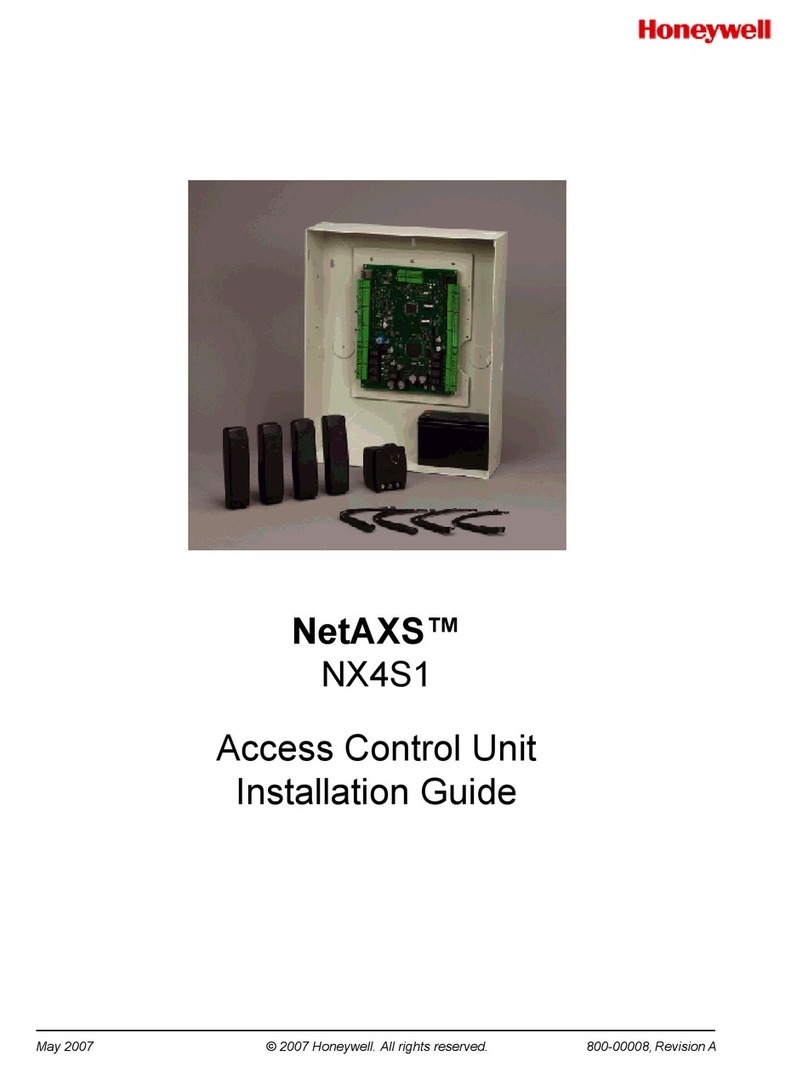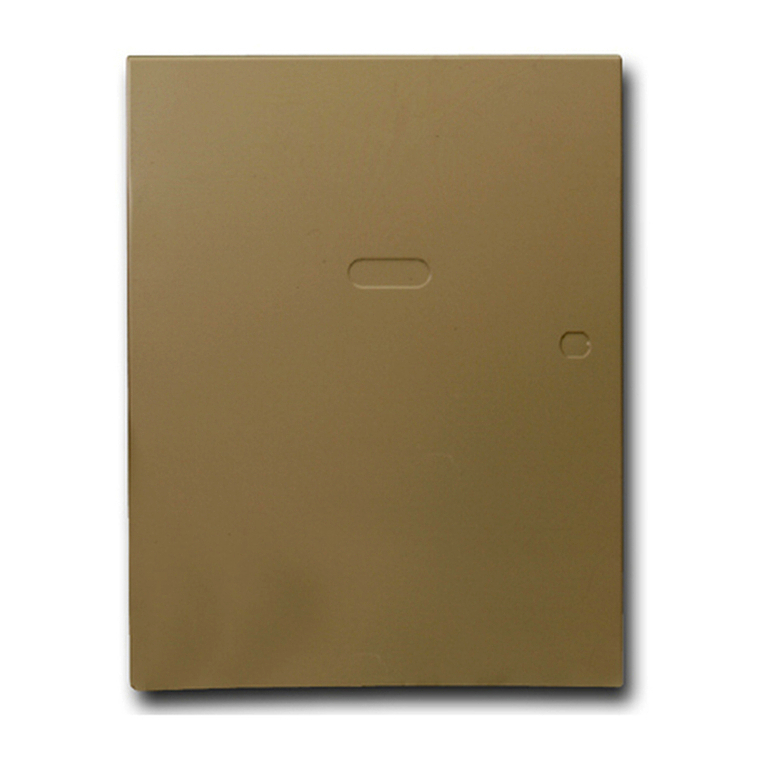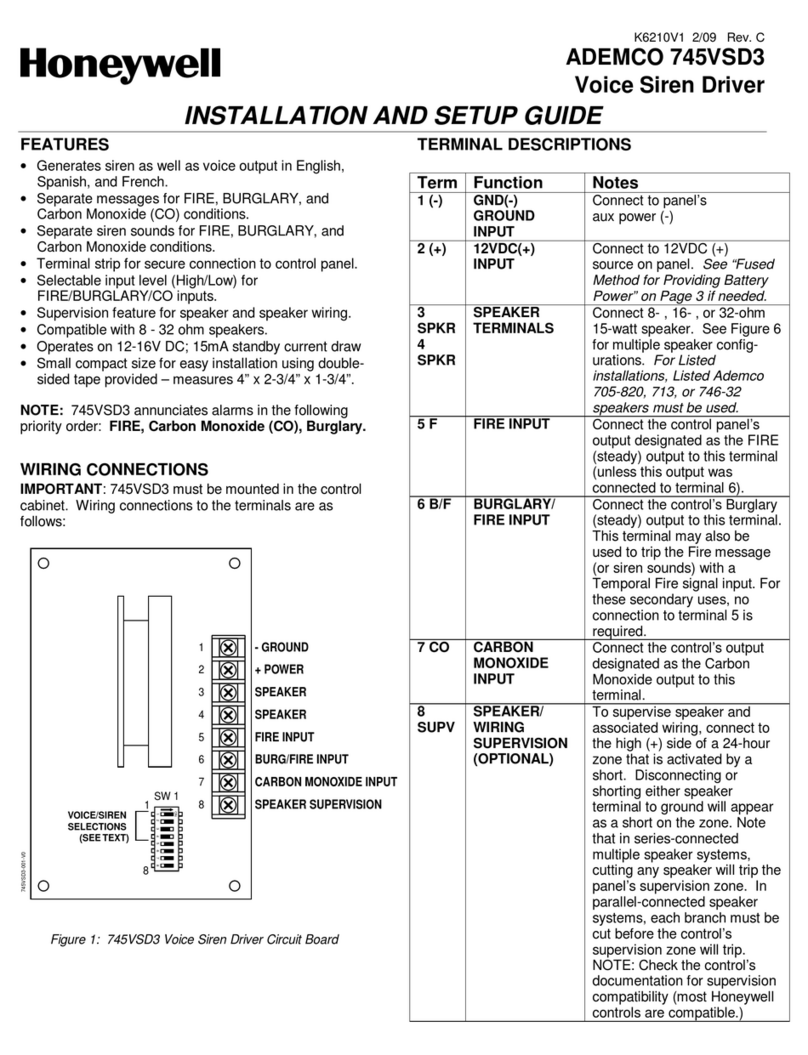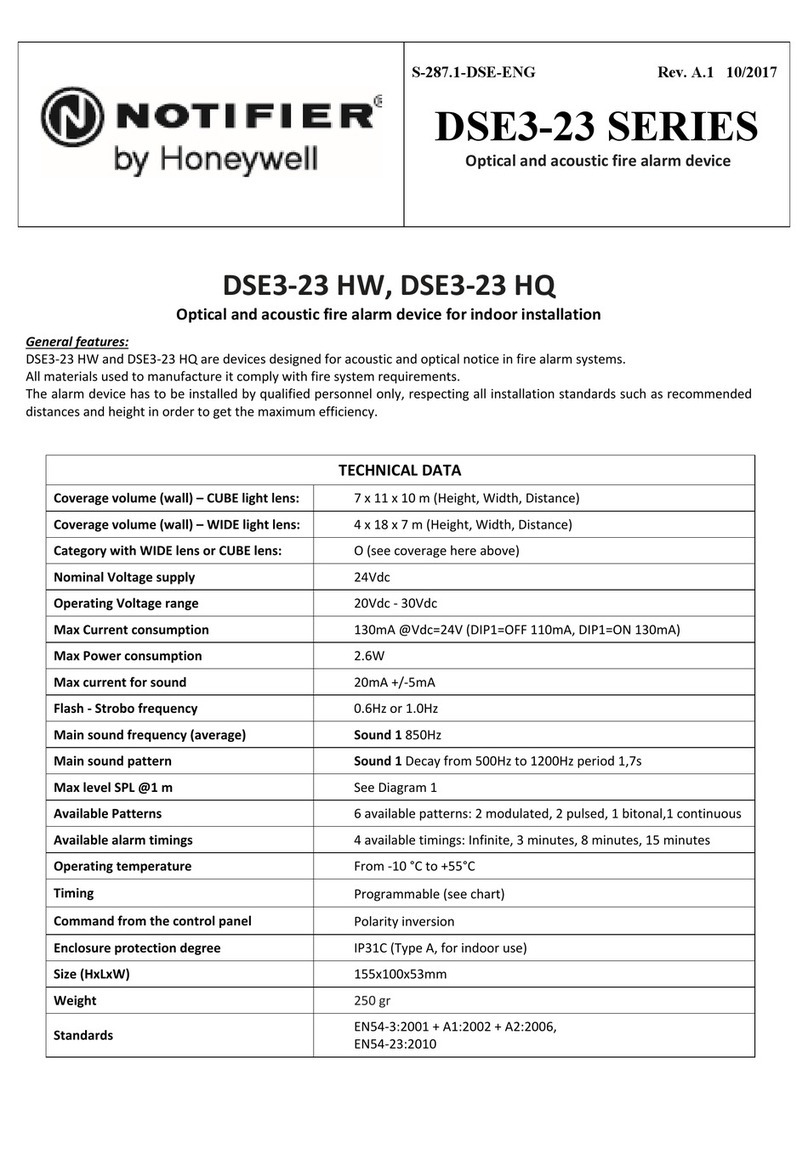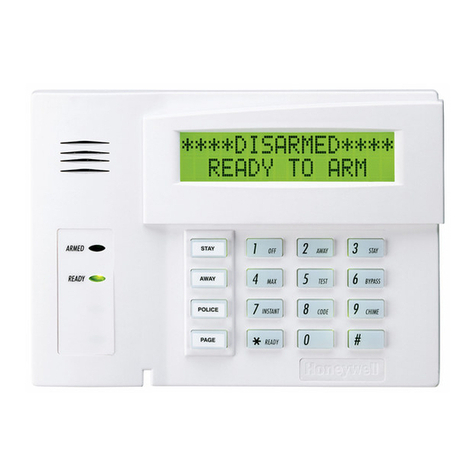
Ê800-16090V1,Š
800-16090V1 12/14 Rev A Part 1
2 Corporate Center Drive, Suite 100
P.O. Box 9040, Melville, NY 11747
Copyright © 2014 Honeywell International Inc.
www.honeywell.com/security
LYNX Touch L7000
Record a Message
Your system can record brief single or multiple messages. The total
available recording time is 184 seconds.
Function
this
Icon…
Perform the following…
Record a
Message
Select “ dd New” to Record a Message.
•Select “Record”.
•Select “Stop” when recording is complete.
Then select “”.
•The recorded message list is displayed.
Select the “” to return to the Security
Home Screen.
Play OR
Delete
Messages
Select the Message that you wish to play
or delete.
•Select “Play” or “Delete ll” as applicable.
•Select the “” to return to the Security
Home Screen.
System Displays
"beeping" at the control, indicates a trouble condition in the system and
requires your attention. Determine if the zone(s) displayed are intact and
make them so if they are not. If the display persists, C LL FOR SERVICE.
Press any key to silence the beeping for these conditions.
The following icons will be displayed on the Home screen along with zone
status information (if applicable) indicating system status:
C Loss
Door Open
Garage
Door Fault
larm
Window
Open
WiFi source
present
rmed
Exit ctive
No WiFi
source
rmed
Stay
Fire OR
Heat
Sensor
103 Comm.
ble
Battery
Low
Flood
90 RF Jam
Check
Zones
Glass Break
Cover
Tamper
Medical
larm
Reporter
Failure
Disarmed
Not Ready
to rm
Motion
utomation
(Z-Wave
Failure)
Disarmed
Ready to
rm
Temperature
See the full User Guide for additional details.
Setting the Date and Time
NOTE: The system must be disarmed before date/time can be set. You
can set the time and date by doing the following:
Use the “” or “” to select the correct month/year.
•Select the correct date. Use the “” to advance.
•Select “Clear” then enter the correct time
•Select M/PM then select “Save” or use the “” to advance.
•Select correct Time Zone
•Enable/disable Day Light Savings Time.
•If required select Day Light Saving Start/End Month/Week.
Select “Save”
Manually Controlling Home Automation Devices
Your system may be equipped Home utomation (Z-Wave) Devices.
These devices are normally controlled using programmed scenes but can
also be activated/controlled manually. To control home automation
devices manually, perform the following:
Mode
Icons… What happens
ctivating
Z-Wave
Devices
+
OR
OR
OR
OR
• You may be able to override
automatically controlled Z-
wave devices using the
utomation commands.
• Some devices can be manually
activated or deactivated using
the utomation commands.
• See your Installer for details
on controlling Z-Wave devices.
For additional information
regarding your system’s Home
utomation features refer to the
full version User Guide and to
the Home utomation Guide
(P/N 800-16091 or later).
Video Camera Control
Your system may be equipped to view and control one or more video
cameras. To view video and/or control the camera, perform the
following:
Select a camera from the displayed list. The selected
camera is highlighted in green.
•Tap the ”Back” button to display the video.
•Control the camera, as applicable, using the displayed
controls.
For additional information regarding video camera features refer to the
LYNX Touch L7000 User Guide (P/N/ 800-16084 or later).
Download the LYNX Connect App
Visit the iTunes or Google Play website to download the LYNX Connect
pp OR scan the applicable code below with your Mobile Device:
IOS Android
Connecting a Mobile Device
Before attempting to connect your Mobile Device to the LYNX Touch
Control Panel, ensure that the LYNX Touch is connected to a WiFi Network
(router). Perform the steps below to connect up to four Mobile Devices to
the LYNX Touch control.
Connect your Mobile Device to the WiFi Network
1. Ensure that you have connected your Mobile Device to the same WiFi
Network as your LYNX Touch L7000 Control Panel. For additional
information refer to the LYNX Touch L7000 User Guide P/N 800-
16084 (or higher).
Connect your Mobile Device to the LYNX Touch
1. t the LYNX Touch Master User screen, select the “Keypad” icon.
2. t the Mobile Device, select the “Lynx Connect” icon.
3. Honeywell License and User greement is displayed. fter reading
the agreement, select “ gree”. You must agree to the terms in order
to use the application.
4. “Discovering Control Panel…” is displayed.
5. Within 10-20 seconds the Device will display the Security Screen or
the Dashboard screen if Total Connect Services are enabled.
6. The control will display ID information for your Mobile Device.
7. Select the “” to return to the Master User Screen.
8. Security Screen is displayed on your Mobile Device, which can now
be used to locally control your system.
LYNX TOUCH L7000 SERIES SECURITY SYSTEM
Quick Guide to User Functions
Full User Guide Available Online: This Quick Guide describes the most frequently used features and functions of your system. For full details of
all user functions, please see the system’s User Guide located online at: http://www.security.honeywell.com/hsc/products (see LYNX Touch
L7000 Security System User Guide P/N 800-16084 or higher). The full version User Guide is also available from your installer upon request.
Congratulations on your ownership of a Honeywell Security System. This system provides:
• Three forms of detection: burglary, fire and emergency (see your installer for which forms of detection are installed)
• t least one keypad which provides control of system and displays system status
• Various sensors for perimeter and interior burglary detection
• Optional smoke or combustion detectors designed to provide early warning in case of fire.
Your system may also be programmed to automatically send alarm and status messages to a Central Monitoring Station.
System Basics
The following is a list of some of the most common features and
functions of your system:
• Several modes of burglary detection: Stay, way, Instant.
• Bypass feature lets you bypass selected zones while leaving the
rest of the system armed.
• Chime mode alerts you to the opening of protected doors and
windows while the system is disarmed.
• Fire and carbon monoxide detection are always active (if
installed) and an alarm sounds if a fire or carbon monoxide
condition is detected.
• Panic keys (if programmed) let you manually initiate fire, police
and medical alarms using the keypad.
• 4-digit security codes are used in conjunction with keypad
commands to perform system functions.
• Each user (up to 48) can be assigned a different security code.
• The system sensing devices have been assigned to various
“zones,” which are specific areas of detection (e.g., front door,
kitchen window, etc.).
• Zone numbers (points of detection) are displayed at the keypad
when an alarm or trouble condition occurs.
• Message Center allows recording and play-back of brief voice
messages.
•Two-way Voice allows the Central Station to listen, talk or
conduct a two-way conversation with in individuals at the
premises. See the full User Guide for details.
• Scheduling feature can be programmed to automatically
perform certain functions (e.g., arm the system) at a
predetermined time each day. See the full User Guide for details.
Entry/Exit Delays
• Entry Delays give you time to disarm the system when you
enter through the designated entrance door.
• You must disarm the system before the entry delay period ends,
or an alarm will occur (keypad beeps during the entry delay
period, reminding you to disarm the system).
• Exit delay gives you time after arming the system to leave
through the designated exit door(s) without setting off an alarm.
If programmed, a slow beeping will sound during the exit delay
period until the last 10 seconds, which then changes to fast
beeping (alerting you to the end of exit delay). If you cannot
leave within this delay time period, you should stop, disarm the
system, and start over to avoid a false alarm.
•
••
• See your installer for your delay times. See the full User Guide
for details on Exit Error alarms.
Notes on Burglary Detection
• The system must be armed before the burglary detection can
sense intrusions.
• To arm your system, select the desired arming key or icon and
enter your security code.
otes on Burglary Detection (Continued)
• To arm your system, if the Quick rm feature is enabled select
the desired arming key or icon followed by the Quick rm icon.
You do not need to enter your security code.
• To disarm the system, select the Disarm icon and enter your
security code.
• When an alarm occurs, the control sounds and displays the
zone(s) causing the alarm. n external sounder may also
sound, if installed.
• If your system is connected to a Central Monitoring Station, an
alarm message is also sent (delayed 30 seconds by default to
reduce false alarms).
• To stop the alarm sounding, simply disarm the system.
• Memory of Alarm: When an alarm condition occurs, the
keypad displays the number(s) of the zone(s) that caused the
problem, and displays the type of alarm. Clear the Memory of
larm display by entering another “off” sequence.
IMPORTANT
If you return to the premises and the burglary sounder is on, or
the keypad beeps rapidly upon entering the premises, it
indicates that an alarm has occurred during your absence and
an intruder may still be on the premises. LE VE IMMEDI TELY
and CONT CT THE POLICE from a nearby safe location.
otes on Fire and CO Detection
• Your fire alarm system (if installed) is on 24 hours a day, for
continuous detection. In the event of an emergency, the
smoke and heat detectors sound their alarms, triggering a
loud, interrupted pulsed sound from the control and any
external sounder(s) (if installed).
• You can silence the alarm at any time by entering an Off
sequence.
• Carbon monoxide (CO) detectors, if installed, provide
continuous detection. If a high level of carbon monoxide is
detected, an interrupted pulsed alarm sound occurs at the
control and the detector(s). Immediately move to a spot
where fresh air is available, preferably outdoors. From a safe
area, call your security service provider for further
instructions. To silence the control sounding, enter an Off
sequence. To silence the detector, see its instructions.
Servicing Information
Your local Honeywell dealer is the person best qualified to service
your alarm system. rranging some kind of regular service program
with him is advisable. Your local H dealer is:
Name:
ddress:
Phone:
